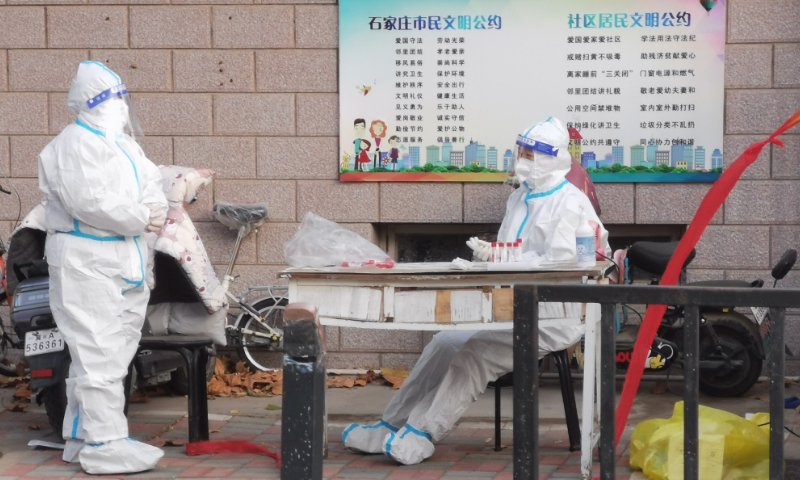
A nucleic acid testing spot in Shijiazhuang, North China's Hebei Province Photo: VCG
Major urban area of Shijiazhuang in North China's Hebei Province announced on Wednesday to resume normal life and production in an orderly manner starting from Thursday, after five rounds of city-wide nucleic acid testing with the results showing that the transmission chains at community level have basically been cut off.
During a press briefing on epidemic prevention and control held on Wednesday, the local authorities announced that differentiated and targeted prevention and control measures will be carried out in the major urban area of the COVID-hit city from December 1.
The city has been placed under static management since early November after the flare-up started in late October.
According to the authorities, a total of 10,357 positive infections have been screened out as of 5 pm on Wednesday after five rounds of city-wide nucleic acid testing.
The number of new infections reached a peak in the second round of testing and started to decline from the third round, particularly with new infections at community level. Experts said that transmission chains at community level of this flare-up in the city have been cut off.
However, sporadic cases can still be discovered at community level, and there are still some high-risk areas, so it remains a tough task to consolidate the prevention and control achievements, the experts noted.
The city will then adjust the prevention and control measures to gradually resume business activities and the service sector closely related to residents' livelihood such as shopping malls, supermarkets and hotels.
People arriving in Shijiazhuang have to take nucleic acid tests and those who have to leave the city much present a negative nucleic acid test result obtained within 48 hours. The city will provide sufficient nucleic acid testing sites and personnel to offer the testing service for free.
The Omicron subvariant BA.5.2 that has caused the flare-up is one of the most transmissible variants which can easily cause large range of transmission due to its highly contagious and fast spreading characteristics, Zhao Yubin, director of Shijiazhuang People's Hospital, said during Wednesday's briefing.
However, it has obviously weaker pathogenicity and virulence which poses limited harm to people's health.
Most infections in this flare-up are asymptomatic carriers and a small number of mild patients have cold-like symptoms, such as fever, sore throat, dry cough, muscle aches and other symptoms. There were very few severe cases, thanks to the situation that most residents have got vaccinated.
Experts said that the positive cases will be treated with classified and precise treatments with a respective and specific therapy for each case.
Global Times




